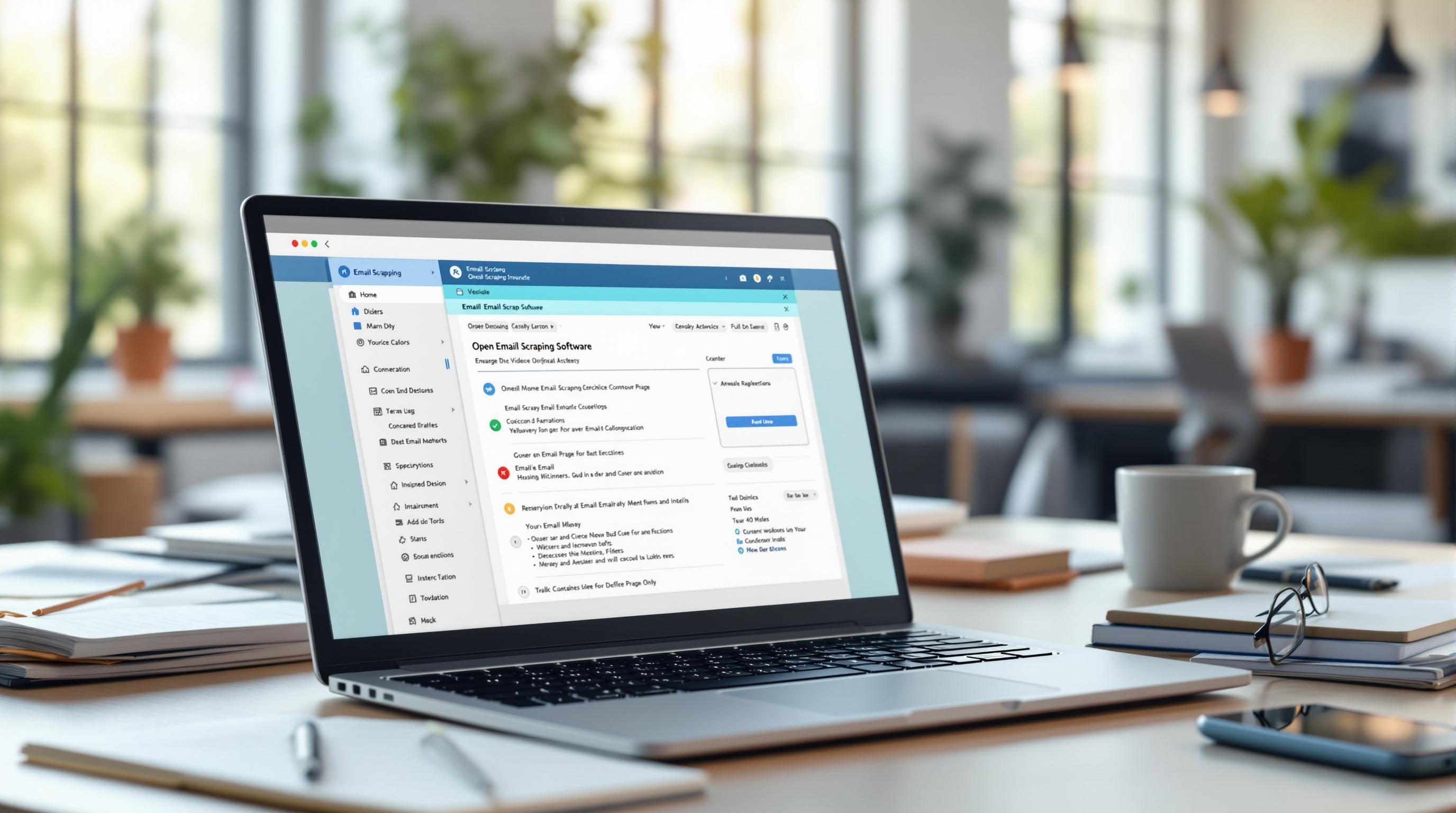AI email scraping helps businesses gather email addresses efficiently but comes with serious security risks. Here's what you need to know:
- What is AI Email Scraping? It uses algorithms to automatically extract email addresses from websites for tasks like lead generation.
- Key Risks: Data breaches, privacy violations, bot attacks, and legal non-compliance (e.g., GDPR, CCPA fines).
- Security Steps: Use encryption (TLS, AES-256), access controls (MFA), rate limiting, CAPTCHAs, and regular security audits.
- Ethical Practices: Always obtain user consent, respect privacy laws, and document permissions.
- Compliance Framework: Follow regulations like GDPR, CCPA, and PIPEDA to avoid penalties.
- Staff Training: Teach employees to recognize threats and handle data securely. Human error remains a major risk.
- Choosing Tools: Look for software with encryption, rate limiting, compliance features, and threat detection.
Quick Tip: Protecting your email scraping operations requires strong technical safeguards, compliance with laws, and ethical data practices.
AI Email Scraping: Methods and Risks
How AI Email Scraping Works
AI email scraping involves the use of web crawlers and natural language processing (NLP) to scan web pages, identify email addresses, and verify their authenticity through pattern recognition and contextual analysis. Tools like Email Extractor Tool simplify this process by integrating compliance measures and secure data handling practices.
The verification process typically includes:
- Pattern matching to identify email formats
- Contextual analysis to confirm valid addresses
- Automated checks to ensure accuracy
While these techniques improve efficiency, they also come with potential security risks that businesses need to address.
Security Risk Analysis
AI email scraping introduces some unique security risks that go beyond standard data protection concerns. Here’s a breakdown:
| Risk Category | Description | Impact Level | Prevention Measures |
|---|---|---|---|
| Server Overload | Excessive scraping can lead to DDoS attacks | Medium | Use rate limiting, CAPTCHAs |
| Bot Attacks | Malicious bots targeting data scraping | Medium | Apply IP filtering, behavior analysis |
| Privacy Violations | Collecting and misusing data without consent | High | Implement permission systems, compliance checks |
Recognizing these challenges is only the first step. It's equally important to take proactive measures to reduce these risks.
Proper Use Guidelines
To safely and ethically use AI email scraping tools, organizations need to clearly define acceptable practices and prioritize data security.
Appropriate Business Applications:
- Collecting leads and conducting market research with proper consent
- Maintaining customer databases with verified and accurate information
Security Measures to Implement:
- Conduct regular security audits
- Configure firewalls to block unauthorized access
- Use systems to detect unusual activity
- Establish rate limiting to prevent overuse
Maintaining ethical standards is just as important as implementing strong security protocols. This means respecting website terms of service, obtaining necessary permissions, and ensuring compliance with data protection laws like GDPR and CCPA [1] [2].
Security Guidelines for Email Scraping
Required Security Steps
Protecting email scraping data starts with strong encryption. Using Data Loss Prevention (DLP) systems is essential to block unauthorized data sharing, especially when dealing with sensitive email information [1][3].
Key Technical Safeguards:
| Security Measure | Implementation | Purpose |
|---|---|---|
| Data Encryption | TLS for transit, AES-256 for storage | Safeguard data from unauthorized access |
| Access Control | Role-based permissions, MFA | Restrict data exposure |
| Network Security | Firewalls, IP filtering | Block unauthorized scraping attempts |
| Monitoring | Real-time alerts, audit logs | Identify and respond to security issues |
While these measures create a secure framework, regular audits ensure systems remain effective and aligned with current security standards.
Security Audit Process
Conducting quarterly security audits helps identify and address weak points in email scraping systems.
Core Elements of an Audit:
1. Vulnerability Assessment
Use reliable tools to scan your infrastructure for outdated software, misconfigurations, or other security flaws.
2. Compliance Review
Ensure your practices align with data protection laws and industry standards [1].
3. Performance Monitoring
Keep an eye on system metrics to spot unusual activity that might signal a security issue [1][3].
Even with advanced technical measures, the human factor plays a critical role in maintaining security. This makes staff training a must-have component.
Staff Security Training
Human error remains one of the biggest risks in email scraping. Research highlights that 94% of organizations faced email security incidents in the past year [1]. This underscores the importance of training employees to recognize and mitigate threats.
Effective Training Practices:
Focus on hands-on, practical training. Security expert Sharon Shea notes that ongoing awareness programs help employees stay updated on best practices and new threats [1].
Topics to cover include:
- Data protection rules, compliance standards, and secure handling of scraped data
- Identifying threats and reporting incidents
- Using encryption tools and other security technologies effectively
"Email security cannot simply be fixed with a tool. It requires awareness and participation from your employees" [1].
Organizations should hold monthly security sessions and use simulation tools to test employees' understanding. Studies show this approach can lower security risks and ensure consistent application of protocols across email scraping operations [1][4].
Laws and Ethics in Email Scraping
Data Protection Laws
AI email scraping operates within a strict legal framework shaped by key regulations. Here are three major ones businesses must navigate:
| Regulation | Key Requirements | Maximum Penalties |
|---|---|---|
| GDPR | Consent, data minimization, erasure rights | €20M or 4% of global revenue |
| CCPA | Opt-out rights, data disclosure, privacy notices | $7,500 per violation |
| PIPEDA | Purpose limitation, consent, data security | Court-ordered damages |
For example, the Austrian Data Protection Authority fined Austrian Post €9 million for mishandling data subject requests, showing the steep penalties for non-compliance [1]. While following these laws is essential, ethical practices help build trust and enhance transparency.
Ethical Email Collection
Transparency is key to earning trust. In fact, 73% of consumers prefer brands that handle data responsibly [1].
Key Ethical Practices:
- Collect and use data only for clearly stated, necessary purposes.
- Keep records accurate and up to date.
- Use strong security measures to protect data.
- Respect user preferences and act on them quickly.
Managing User Permissions
Ethical practices extend to managing permissions effectively, ensuring compliance and user confidence.
"Consent is an opportunity to engage with genuinely interested audiences." - Zoe Aughinbaugh, Email Marketing Guru [1]
Best Practices for Permission Management:
- Use clear opt-in options that explain how data will be used.
- Keep detailed records of user consent.
- Offer easy and fast opt-out mechanisms.
The Meta vs Bright Data case emphasized how proper documentation can support legitimate scraping practices [5].
sbb-itb-8abf799
Selecting Email Scraping Software
Security Features Checklist
With data breaches averaging a cost of $4.35 million per incident [1], choosing secure email scraping software is essential for protecting your business. Here are key security features to prioritize:
| Security Feature | Purpose | Impact |
|---|---|---|
| Encryption & Access Control | Protects data and restricts access | Blocks unauthorized usage |
| Rate Limiting & Monitoring | Regulates requests and tracks activity | Reduces risks of abuse and attacks |
| Compliance Framework | Aligns with GDPR/CCPA requirements | Ensures legal adherence |
| Threat Detection | Spots unusual behavior | Allows for quick mitigation |
Email Extractor Tool - Extract Emails with AI Automation

When focusing on security, the Email Extractor Tool stands out by offering AI-driven email extraction paired with advanced safety features. Its capabilities include:
- Top-tier encryption to safeguard your data
- Secure export options in formats like CSV and TXT
- Automated compliance tools to meet data protection regulations
These tools allow for efficient email extraction while ensuring your processes remain compliant with privacy laws.
Vendor Security Assessment
Choosing a trustworthy vendor is key to reducing risks associated with email scraping. A detailed review of their security measures can help shield your organization from potential cyber threats.
"Data scraping can become a significant threat to cybersecurity when used improperly." - Cybersecurity Insiders [1]
Steps to Evaluate a Vendor:
-
Security and Compliance Review
- Check their encryption methods and data storage policies
- Confirm certifications and adherence to security standards
- Request audit reports and supporting documentation
-
Incident Response Assessment
- Investigate how they handle security incidents
- Look into their history of resolving past issues
- Understand their communication process during breaches
A vendor's approach to security plays a pivotal role in protecting your organization. Regularly assessing their practices ensures they can handle evolving threats effectively.
Conclusion
Summary of Key Points
Protecting sensitive data in AI email scraping requires a well-rounded approach. Organizations should focus on multiple areas to ensure strong security measures:
| Security Aspect | Key Components | Business Impact |
|---|---|---|
| Technical Protection | Encryption, Rate Limiting, Monitoring | Safeguards against data breaches and misuse |
| Legal Compliance | GDPR/CCPA Adherence, User Permissions | Helps avoid fines and legal complications |
| Operational Security | Staff Training, Security Audits | Minimizes errors and strengthens overall defense |
By addressing these areas, businesses can take practical steps to enhance their security strategies.
Next Steps
To improve your AI email scraping security, consider these steps:
1. Conduct a Security Assessment
Start with a detailed review of your current practices. Evaluate encryption methods, access controls, and monitoring systems. Given that 71% of websites face daily scraping attempts [3], establishing baseline security metrics is crucial.
2. Implement Technical Safeguards
Put in place effective security measures such as:
- Encrypting data and ensuring secure storage
- Using rate limiting to prevent misuse
- Setting up real-time monitoring to detect threats
3. Build a Compliance Framework
Create a framework that clearly documents data collection processes, manages user permissions, and keeps privacy policies up to date.
Maintaining strong security in AI email scraping involves ongoing effort and ethical practices. By following these steps, businesses can stay compliant and foster trust with users and stakeholders.
FAQs
How can AI security risks be minimized?
Reducing AI security risks requires a layered defense strategy. Experts recommend the following measures to protect against threats:
| Security Layer | Implementation | Purpose |
|---|---|---|
| Data Protection | Encryption and validation | Prevent unauthorized access |
| Access Control | Permission management | Reduce system vulnerabilities |
| Monitoring & Response | Real-time tracking and incident management | Quickly detect and address threats |
"Prompt injection is currently the most common form of attack observed against LLMs" [2].
Prompt injection occurs when attackers manipulate AI outputs by feeding malicious or deceptive instructions into the input. Given that the average cost of a data breach has reached $4.35 million [1], adopting these measures is essential for safeguarding business operations. These layers provide a strong foundation for protecting AI email scraping tools from potential risks.
Being aware of these threats is critical to implementing secure and responsible email scraping practices.
What does email scraping involve?
Email scraping is the process of using AI to automatically gather email addresses from online sources. While it can support legitimate activities like lead generation, it is also misused for malicious purposes, including cyberattacks.
To ensure safe and ethical practices, organizations should use tools equipped with built-in security features, comply with user privacy laws, and monitor for unusual usage patterns. Striking a balance between efficiency and security is key, ensuring compliance with regulations while protecting against potential threats.



